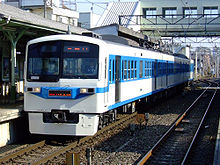- Chichibu Railway
-
Chichibu Railway Co., Ltd.
秩父鉄道株式会社Type Public K.K. (JASDAQ: 9012) Industry Railway Founded 8 November 1899 Headquarters Kumagaya, Saitama, Japan Key people Shigetoshi Arafune (CEO) Employees 356 (601 incl. related businesses) Website www.chichibu-railway.co.jp Chichibu Railway Co., Ltd. (秩父鉄道株式会社 Chichibu Tetsudō Kabushiki-gaisha) (JASDAQ: 9012) is a small-sector private railway company operating two railway lines in northern Saitama Prefecture, Japan. In addition to its railway operations, the company deals in the real estate and tourism industries. It also manages the Mitsumine Ropeway (三峰ロープウェイ). The aerial tramway line, however, closed in December 2007.
Taiheiyo Cement is its largest shareholder, and one of Chichibu Railway's main operations is the transportation of limestone from Mount Bukō. The railway's passenger services concentrate on the tourism industry, as there are popular destinations along the line. A train hauled by a steam locomotive also operates regularly during some seasons, attracting tourists from around the country.
Contents
Lines
Railway lines
- Chichibu Mainline (秩父本線): from Hanyū to Mitsumineguchi (passenger line)
- Mikajiri Line (三ヶ尻線): from Takekawa to Kumagaya Kamotsu Terminal (freight line)
Aerial tramway lines
- Mitsumine Ropeway at Mitsumineguchi (closed in December 2007)
History
- 8 November 1899 - Founded as Jōbu Railway (Headquartered in now-defunct Nihonbashi Ward, Tokyo City).[1]
- 7 October 1901 - Started operations between Kumagaya and Yorii.[1]
- 1916 - Company name changed to Chichibu Railway.
- 1921 - Started operations between Hokubu Railway's Hanyu station and Gyoda Station (now Gyodashi station).
- 1922 - Chichibu Railway acquired Hokubu Railway.[1]
- 1930 - Started operations on the full line between Hanyu and Mitsumineguchi.
- 1954 - Started direct operations with the Tōbu Tōjō Line.
- 1980 - Headquarters moved to Kumagaya, Saitama.
- 1988 - Started operations of a steam locomotive-hauled train, the Paleo Express.
- 1989 - Started direct operations with Seibu Railway.
- 1997 - Moved bus operations to a separate entity, Chichibu Railway Sightseeing Bus Co., Ltd.
See also
References
External links
- Chichibu Railway website (Japanese)
Chichibu Railway rolling stock Local EMUs 100 series • 500 series • 800 series • 1000 series • 2000 series • 5000 series • 7000 series • 7500 seriesExpress EMUs Locomotives C58 • ED38 • DeKi 1 • DeKi 100 • DeKi 200 • DeKi 300 • DeKi 500Coaches 12 seriesCategories:- Companies listed on the JASDAQ Securities Exchange
- Railway companies of Japan
- Companies based in Saitama Prefecture
- Chichibu Railway
Wikimedia Foundation. 2010.

